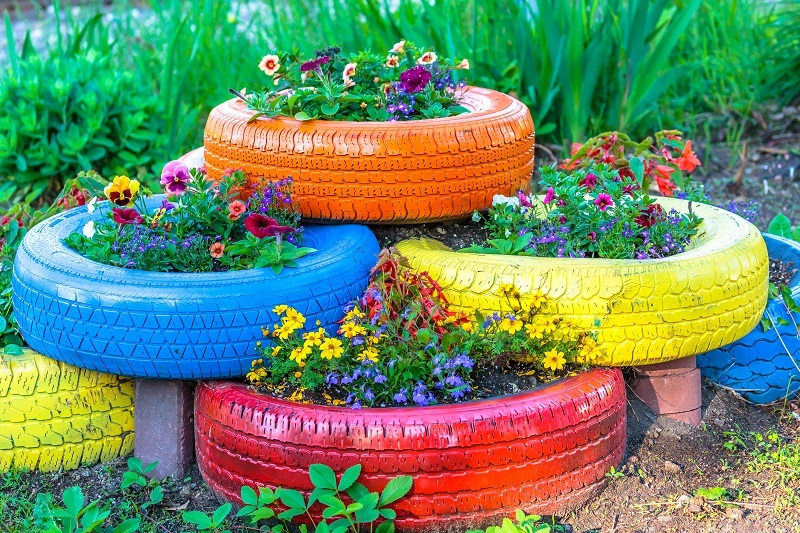Immerse yourself in the surprising world of sunflower facts
Posted on 13/08/2025
Immerse Yourself in the Surprising World of Sunflower Facts
What do Vincent van Gogh, summertime fields, birds, and even astronauts have in common? It might surprise you, but the answer is the radiant, ever-cheerful sunflower! Sunflower facts are much more enthralling than simply noting their height or color. Behind their iconic yellow petals lies a botanical marvel with a deep history, surprising science, and vital importance for people, wildlife, and the environment. If you've ever been captivated by a sunflower's smile, this detailed article will guide you through the lesser-known wonders, curiosities, and hidden tales that make the world of sunflowers truly unforgettable.
Unveiling the Origins: Where Did Sunflowers Come From?
Before diving into little-known sunflower facts, it's helpful to understand their origins. The sunflower, or Helianthus annuus, is native to North America. Archaeological records show wild sunflowers were domesticated as early as 3000 BC by Native American cultures, who cultivated them for food, oil, dye, and even construction materials.
Sunflower Domestication: An Ancient Partnership
- Native uses: Sunflower seeds were crushed for flour, pounded into cakes, or pressed for oil.
- Diverse roles: The entire plant--leaves, stalks, petals--was utilized for dye, cordage, or ceremonial purposes.
- Global traveler: Spanish explorers later introduced sunflowers to Europe, where their beauty and utility quickly won hearts.
The journey continued from Russia, where sunflowers were bred for larger seeds and higher oil content, to the entire world. Today, the sunflower is a truly global flower, rooted in North American heritage.

The Science of Sunflowers: More Than Just a Pretty Face
Beneath their golden exterior, sunflowers have a unique botanical structure and scientific intrigue. Let's explore what makes these bright blossoms so remarkable.
Not Just One Flower: Sunflowers are Inflorescences!
Most people picture a sunflower head as a single large flower. But you might be surprised to learn that what you see is actually an inflorescence: a composite arrangement of hundreds or even thousands of tiny individual flowers!
- The big "face" is the flowering head or capitulum, containing ray florets (the yellow "petals" around the edge) and disc florets (the small, seed-producing flowers at the center).
- Each disc floret will eventually turn into a seed, meaning a single head can produce up to 2,000 seeds!
The Mathematics of Sunflower Spirals
Have you noticed the mesmerizing spiral patterns in a sunflower's center? That isn't random; it's Nature's mathematics at work, known as the Fibonacci sequence.
- Each seed is perfectly placed at a unique angle, allowing the most efficient packing and optimal exposure.
- This arrangement ensures space, maximizes sunlight absorption, and strengthens the flower against wind and rain.
- Fun Fact: The angle is approximately 137.5?, also called the "golden angle" or "divine proportion" in mathematics and art.
Heliotropism: Sunflowers Follow the Sun!
One of the most fascinating sunflower plant facts is their famous sun-tracking behavior, called heliotropism. Young, budding sunflowers will move their heads to face the sun throughout the day--from east in the morning to west in the evening--in a process that helps them maximize their photosynthesis and growth.
- This dynamic movement is due to special growth hormones and cells in the stem that elongate on the shaded side.
- As sunflowers mature and bloom, they usually settle facing east. This orientation helps attract pollinators by warming up early in the day!
Sunflowers in Human Life: From Food to Symbolism
The impact of sunflowers in human culture and industry is massive. Beyond their beauty, sunflowers play a major role as a food source, industrial product, and even a symbol of hope and joy.
Sunflower Seeds: A Nutritional Powerhouse
- Rich in healthy fats: Sunflower seeds are an excellent source of plant-based omega-6 fatty acids and unsaturated fats, which are good for heart health.
- Packed with vitamins: They contain vitamin E, magnesium, selenium, and protein, making them a popular snack for athletes and health enthusiasts.
- Culinary versatility: Toasted, raw, ground into butter, or pressed for oil--sunflower products are used in cuisines around the world.
Sunflower Oil: Liquid Gold for Cooking and Beyond
- World's leading edible oil: Sunflower oil is among the top vegetable oils used globally, prized for its mild taste and high smoke point.
- It's abundant in vitamin E and is cholesterol-free, making it a staple in kitchens and for salad dressings.
- Apart from food, sunflower oil finds uses in cosmetics, soap, and biodiesel industries.
More Than Food: Surprising Uses of Sunflowers
- Bird and animal feed: Sunflower seed heads are favorites of garden birds, squirrels, and other wildlife.
- Natural pollution fighters: Sunflowers have shown a unique ability to pull toxins and heavy metals from contaminated soil--a process called phytoremediation. After disasters like Chernobyl and Fukushima, sunflowers helped clean up affected areas.
- Materials and dyes: Native Americans and pioneers used sunflower stalks for building materials, and petals for vibrant dyes.
Sunflower Symbolism: Sunshine, Hope, and Loyalty
Sunflowers are not just botanical wonders; they are cultural icons. Their bold, open faces and dazzling yellow petals have inspired countless people, artists, and writers. Here are a few symbolic associations:
- Joy and positivity: Their sunny appearance makes sunflowers universal symbols of happiness and optimism.
- Loyalty and longevity: Their tendency to "follow" the sun symbolizes faithfulness and long-lasting affection.
- Spiritual significance: Some cultures believe sunflowers represent spiritual knowledge or enlightenment, always seeking the light.
- Modern movements: The sunflower has been adopted by environmental and peace groups for its resilience and hope.
Record-Breaking Sunflowers: Astounding and Amusing Feats
The Tallest Sunflower on Record
Think your garden's sunflowers are tall? The world's tallest sunflower reached a dizzying height of 9.17 meters (30 feet 1 inch)! Grown by Hans-Peter Schiffer in Germany, this sunflower towered over the competition, earning a spot in the Guinness World Records.
Largest Sunflower Head
As if being tall wasn't enough, the largest sunflower head ever measured eclipsed 82 cm (32 inches) in diameter, grown by Emily Martin in Canada. Imagine extracting thousands of seeds from a single head as wide as a hula hoop!
Sunflowers in Space: Out of This World!
In 2012, astronaut Don Pettit grew sunflowers aboard the International Space Station, conducting experiments in zero gravity. Even in space, the allure of sunflowers is irresistible!
Sunflowers in Art, Literature, and Pop Culture
Immortality in paint and poetry--sunflowers have inspired creative minds throughout history.
- Van Gogh's masterpieces: His series of "Sunflowers" paintings (1888-89) remain among the most celebrated and expensive artworks ever created.
- Across cultures: From Chinese murals to Ukrainian folk art, sunflowers symbolize good fortune, fertility, and resilience.
- Music and film: Their symbolic presence appears in songs, movies, and contemporary art installations worldwide.
Growing Sunflowers: Tips for Home Gardeners
Fascinated by these amazing sunflower facts? Why not bring the magic into your own backyard! Sunflowers are easy to grow, hardy plants suitable for beginners and kids.
How to Grow Sunflowers
- Choose a sunny spot: Sunflowers need at least 6-8 hours of direct sunlight daily.
- Prepare the soil: Loose, well-drained soil boosts growth. Add compost for extra nutrition.
- Sow seeds after frost: Directly plant seeds outdoors in late spring, spacing them about 6 inches apart.
- Water consistently: Keep soil moist, especially during germination and early growth.
- Stake tall varieties: If growing giant types, provide support to prevent wind damage.
Tip: Choose from dozens of varieties--giant skyscrapers, branching types, even dwarf sunflowers for pots!
Harvesting and Enjoying Sunflowers
- For seeds: Let the heads mature and dry before harvesting seeds. Protect from birds with mesh if needed!
- Bouquets: Cut flower stems when heads are just opening for vibrant, long-lasting arrangements.
- Wildlife: Leave a few seed heads for birds in autumn.

Mind-Blowing Sunflower Trivia and Amazing Lesser-Known Facts
- What's in a name? The genus Helianthus comes from Greek helios (sun) and anthos (flower).
- Edible everything: You can eat sunflower buds, petals, and even young stalks like a vegetable.
- Global crop: Sunflowers rank among the world's top four oilseed crops (with soy, canola, and palm).
- Bees love them: Sunflowers support pollinators and make excellent bee forage, helping stabilize local ecosystems.
- Mini-sunflowers: Some dwarf types only grow 12 inches tall--perfect for containers and balconies.
- Color range: Not all sunflowers are yellow! Cultivars bloom in red, orange, bronze, burgundy, cream, and even bicolor patterns.
- Genetic diversity: There are around 70 recognized species of Helianthus, from wild perennials to common annuals.
Why You Should Celebrate Sunflowers
Sunflowers are more than a summertime decoration; they're a botanical powerhouse, historical icon, and natural wonder rolled into one. Their impact on agriculture, art, science, and the environment is undeniable. By growing or supporting sunflowers, you're enriching pollinators, nourishing your body, and contributing to a brighter, more sustainable world.
Next time you pass a blooming sunflower or pinch a handful of its seeds, remember: you're connected to an ancient human story, the mysteries of mathematics, and a legacy of optimism and beauty. Immerse yourself in the surprising world of sunflower facts--and let their golden light inspire you!
Further Reading: Expand Your Sunflower Knowledge
- USDA Plant Profile: Helianthus annuus
- National Sunflower Association
- Guinness World Records: Tallest Sunflower
Start your own journey with sunflowers today--plant a seed, share a smile, and experience firsthand the wonders of this extraordinary flower!







